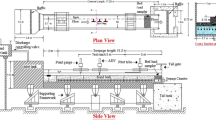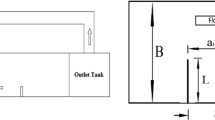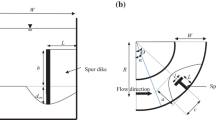Abstract
Spur dikes are frequently preferred flow regulation structures, especially for open channels and coastal morphology due to their ease of application and economics. Since spur dikes placed on the edge of the stream isolated (single) or in groups do not have a length across the entire channel width, they can also play the role of a semi-permeable weir in the stream. In this study, the effects of spur dikes of the same length and height placed asymmetrically on both sides of the channels at five different angles on the flow were investigated experimentally and numerically. The energy dissipation ratios of the spur dikes in the channel were calculated in submerged and unsubmerged flow conditions. A total of 45 tests were performed using nine different discharges, and comparisons were made by transferring the same characteristics from the experimental conditions to the numerical environment. According to the obtained data, the situation with the highest energy dissipation occurred at θ = 120°. At low discharges, more vortex was observed in the eyes between the dikes, but as the discharge increased, the vortex seen in the flow decreased. The velocity distributions on the channel cross-sections were also presented to obtain flow patterns along disturbed flow in the channel. At the maximum discharge, the θ = 30° placement showed the highest velocities in most cross-sections, while the lowest velocities were observed at the θ = 120°.







Similar content being viewed by others
Data Availability
The data for this study are available upon reasonable request from the corresponding author.
References
Acharya A, Acharya A, Duan JG (2013) Three dimensional simulation of flow field around series of spur dikes. Int Ref J Eng Sci 2:36–57. https://doi.org/10.1061/41173(414)218
Atarodi A, Karami H, Ardeshir A et al (2021) Experimental investigation of scour reduction around spur dikes by collar using Taguchi method. Iran J Sci Technol - Trans Civ Eng 45:971–983. https://doi.org/10.1007/s40996-020-00373-1
Aydin MC, Aytemur HS, Ulu AE (2022) Experimental and numerical investigation on hydraulic performance of slit-check dams in subcritical flow condition. Water Resour Manag 36:1693–1710. https://doi.org/10.1007/s11269-022-03103-6
Azinfar H, Kells JA (2007) Backwater effect due to a single spur dike. Can J Civ Eng 34:107–115. https://doi.org/10.1139/L06-117
Azinfar H, Kells JA (2011) Drag force and associated backwater effect due to an open channel spur dike field. J Hydraul Res 49:248–256. https://doi.org/10.1080/00221686.2011.552470
Azinfar H, Kells JA (2009) Flow resistance due to a single spur dike in an open channel. J Hydraul Res 47:755–763. https://doi.org/10.3826/jhr.2009.3327
Biron PM, Robson C, Lapointe MF, Gaskin SJ (2004) Deflector designs for fish habitat restoration. Environ Manag 33:25–35. https://doi.org/10.1007/s00267-003-3080-9
Celik IB, Ghia U, Roache PJ et al (2008) Procedure for estimation and reporting of uncertainty due to discretization in CFD applications. J Fluids Eng Trans ASME 130:0780011–0780014. https://doi.org/10.1115/1.2960953
Duan JG, He L, Fu X, Wang Q (2009) Mean flow and turbulence around experimental spur dike. Adv Water Resour 32:1717–1725. https://doi.org/10.1016/j.advwatres.2009.09.004
Ettema R, Muste M (2004) Scale effects in flume experiments on flow around a spur dike in flatbed channel. J Hydraul Eng 130:635–646. https://doi.org/10.1061/(asce)0733-9429(2004)130:7(635)
FLOW-3D (2019) FLOW-3D User Manual Flow Science, Inc. Santa Fe, NM
Granados JM, Bustamante CA, Toro-Botero FM et al (2022) Wall shear stress in open channel flow using different configurations of groynes. ISH J Hydraul Eng 00:1–9. https://doi.org/10.1080/09715010.2022.2026827
Gu Z, Cao X, Jiao Y, Lu WZ (2016) Appropriate CFD models for simulating flow around spur dike group along urban riverways. Water Resour Manag 30:4559–4570. https://doi.org/10.1007/s11269-016-1436-1
Haider R, Qiao D, Yan J et al (2022) Flow characteristics around permeable spur dike with different staggered pores at varying angles. Arab J Sci Eng. https://doi.org/10.1007/s13369-021-06435-4
Han X, Lin P, Parker G (2022) Influence of layout angles on river flow and local scour in grouped spur dikes field. J Hydrol 614:128502. https://doi.org/10.1016/j.jhydrol.2022.128502
Han X, Lin P, Parker G (2019) 3D numerical study on local scour around spur dikes with different layout angles. IAHR World Congr - Water Connect World 38:1587–1594. https://doi.org/10.3850/38wc092019-0394
Hirt CW, Nichols BD (1981) Volume of fluid (VOF) method for the dynamics of free boundaries. J Comput Phys 39:201–225. https://doi.org/10.1016/0021-9991(81)90145-5
Kakati R, Chembolu V, Dutta S (2022) Experimental and numerical investigation of hybrid river training works using OpenFOAM. Water Resour Manag 36:2847–2863. https://doi.org/10.1007/s11269-022-03181-6
Koken M, Constantinescu G (2011) Flow and turbulence structure around a spur dike in a channel with a large scour hole. Water Resour Res 47. https://doi.org/10.1029/2011WR010710
Kumar S, Pradhan A, Ranjan J et al (2023) Evaluation of flow resistance using multi - gene genetic programming for bed - load transport in gravel - bed channels. Water Resour Manag. https://doi.org/10.1007/s11269-022-03409-5
Mavrommatis A, Christodoulou G (2022) Comparative experimental study of flow through various types of simulated vegetation. Environ Process 9:1–15. https://doi.org/10.1007/s40710-022-00576-w
Möws R, Koll K (2019) Roughness effect of submerged groyne fields with varying length, groyne distance, and groyne types. Water (Switzerland) 11. https://doi.org/10.3390/w11061253
Mulahasan S, Saleh MS, Muhsun SS (2023) Simulation of flow around a permeable dike using physical and 3D-CFD models. Int J River Basin Manag 21(1):53–65. https://doi.org/10.1080/15715124.2021.1901726
Nafchi FR, Vanani RH, Pashaee NK et al (2022a) Investigation on the effect of inclined crest step pool on scouring protection in erodible river beds. Nat Hazards 110:1495–1505. https://doi.org/10.1007/s11069-021-04999-w
Nafchi RF, Samadi-Boroujeni H, Vanani HR et al (2021) Laboratory investigation on erosion threshold shear stress of cohesive sediment in Karkheh Dam. Environ Earth Sci 80:1–15. https://doi.org/10.1007/s12665-021-09984-x
Nafchi RF, Yaghoobi P, Vanani HR et al (2022b) Correction to: Eco-hydrologic stability zonation of dams and power plants using the combined models of SMCE and CEQUALW2. Appl Water Sci (2021) 11(7):109. https://doi.org/10.1007/s13201-021-01427-z. Appl Water Sci 12:1. https://doi.org/10.1007/s13201-021-01563-6
Ning J, Li G, Li S (2019) Numerical simulation of the influence of spur dikes spacing on local scour and flow. Appl Sci 9. https://doi.org/10.3390/app9112306
Roache PJ, Ghia KN, White FM (1986) Editorial policy statement on the control of numerical accuracy. Mech Eng 108:2011–2011
Shayannejad M, Ghobadi M, Ostad-Ali-Askari K (2022) Modeling of surface flow and infiltration during surface irrigation advance based on numerical solution of saint-venant equations using preissmann’s scheme. Pure Appl Geophys 179:1103–1113. https://doi.org/10.1007/s00024-022-02962-9
Tayfur G (2021) Empirical, numerical, and soft modelling approaches for non-cohesive sediment transport. Environ Process 8:37–58. https://doi.org/10.1007/s40710-020-00480-1
Tu J, Yeoh G-H, Liu C (2018) CFD solution analysis: Essentials. In: Computational Fluid Dynamics. Elsevier, pp 211–253. https://doi.org/10.1016/b978-0-08-101127-0.00006-4
Uijttewaal WS (2005) Effects of groyne layout on the flow in groyne fields: Laboratory experiments. J Hydraul Eng 131:782–791. https://doi.org/10.1061/(asce)0733-9429(2005)131:9(782)
Yang J, Shen Z, Zhang J et al (2022) Experimental and numerical investigation of flow over a spillway bend with different combinations of permeable spur dikes. Water Supply 22:1557–1574. https://doi.org/10.2166/ws.2021.335
Zhang H, Nakagawa H (2008) Scour around spur dyke: Recent advances and future researches. Annu Disas Prev Res Inst 51:633–652
Acknowledgements
This study was produced from Ali Emre ULU’s ongoing PhD thesis.
Author information
Authors and Affiliations
Contributions
Material preparation, experiments, and numerical analysis were performed by A.E.U, M.C.A and F.Ö. A.E.U. wrote the manuscript’s initial draft, and all authors provided assessments and contributions on each version of the paper.
Corresponding author
Ethics declarations
Competing Interests
The authors have no relevant financial or non-financial interests to disclose.
Additional information
Publisher's Note
Springer Nature remains neutral with regard to jurisdictional claims in published maps and institutional affiliations.
Rights and permissions
Springer Nature or its licensor (e.g. a society or other partner) holds exclusive rights to this article under a publishing agreement with the author(s) or other rightsholder(s); author self-archiving of the accepted manuscript version of this article is solely governed by the terms of such publishing agreement and applicable law.
About this article
Cite this article
Ulu, A.E., Aydin, M.C. & Önen, F. Energy Dissipation Potentials of Grouped Spur Dikes in an Open Channel. Water Resour Manage 37, 4491–4506 (2023). https://doi.org/10.1007/s11269-023-03571-4
Received:
Accepted:
Published:
Issue Date:
DOI: https://doi.org/10.1007/s11269-023-03571-4




